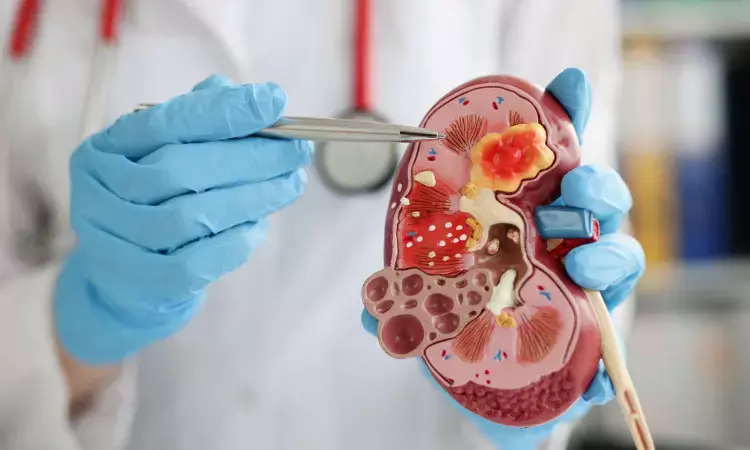- Home
- Medical news & Guidelines
- Anesthesiology
- Cardiology and CTVS
- Critical Care
- Dentistry
- Dermatology
- Diabetes and Endocrinology
- ENT
- Gastroenterology
- Medicine
- Nephrology
- Neurology
- Obstretics-Gynaecology
- Oncology
- Ophthalmology
- Orthopaedics
- Pediatrics-Neonatology
- Psychiatry
- Pulmonology
- Radiology
- Surgery
- Urology
- Laboratory Medicine
- Diet
- Nursing
- Paramedical
- Physiotherapy
- Health news
- Fact Check
- Bone Health Fact Check
- Brain Health Fact Check
- Cancer Related Fact Check
- Child Care Fact Check
- Dental and oral health fact check
- Diabetes and metabolic health fact check
- Diet and Nutrition Fact Check
- Eye and ENT Care Fact Check
- Fitness fact check
- Gut health fact check
- Heart health fact check
- Kidney health fact check
- Medical education fact check
- Men's health fact check
- Respiratory fact check
- Skin and hair care fact check
- Vaccine and Immunization fact check
- Women's health fact check
- AYUSH
- State News
- Andaman and Nicobar Islands
- Andhra Pradesh
- Arunachal Pradesh
- Assam
- Bihar
- Chandigarh
- Chattisgarh
- Dadra and Nagar Haveli
- Daman and Diu
- Delhi
- Goa
- Gujarat
- Haryana
- Himachal Pradesh
- Jammu & Kashmir
- Jharkhand
- Karnataka
- Kerala
- Ladakh
- Lakshadweep
- Madhya Pradesh
- Maharashtra
- Manipur
- Meghalaya
- Mizoram
- Nagaland
- Odisha
- Puducherry
- Punjab
- Rajasthan
- Sikkim
- Tamil Nadu
- Telangana
- Tripura
- Uttar Pradesh
- Uttrakhand
- West Bengal
- Medical Education
- Industry
Patients with kidney stones undergoing 'Mini-PCNL' surgery have higher likelihood of achieving stone-free status

USA: Mini-percutaneous nephrolithotomy (mini-PCNL) more likely renders patients stone-free than another minimally invasive procedure called ureteroscopy (URS) for patients with kidney stones measuring one to two centimetres, a randomized trial has shown.
There was no variation in the two approaches for surgical times, complications, and operating margins. The findings were published in The Journal of Urology, an Official Journal of the American Urological Association (AUA).
"In our clinical trial, mini-PCNL was more likely to achieve stone-free outcomes, compared to URS," comments senior author Jorge Gutierrez-Aceves, MD, of the Cleveland Clinic. "In patients with intermediate-sized kidney stones, mini-PCNL may offer a more effective procedure, with similar safety and cost impact."
Trial compares minimally invasive surgeries for intermediate stones
Kidney stones are one of the problems most commonly seen by urologists. In current AUA guidelines, conventional PCNL surgery is recommended for patients with stones larger than two centimeters, while less-invasive treatments are recommended for symptomatic stones smaller than one centimeter.
However, there is ongoing debate over treatment for intermediate-size stones-measuring one to two centimeters. In the URS procedure, kidney stones are approached using a small instrument (ureteroscope) placed through the urethra and bladder.
Mini-PCNL offers an alternative approach, with treatment carried out through a small incision (sometimes called a keyhole incision) in the patient's side. Previous studies comparing the outcomes of URS and mini-PCNL have had important limitations.
In the new study, 101 patients with one- to two-centimeter kidney stones were randomly assigned to treatment with URS or mini-PCNL. All patients had a single intermediate-sized stone in one kidney. In both procedures, once the surgeon visualized the stone through instruments placed into the kidney, the stone was fragmented using a laser and removed using a basket device.
Mini-PCNL has higher stone-free rate than URS, with similar safety
The main outcome of interest was the stone-free rate, defined as no residual stone larger than two millimeters on postoperative CT scans. By this definition, 76% of patients were stone-free after mini-PCNL, compared to 46% after URS. The mini-PCNL group also had a lower total volume of residual stone fragments after treatment: 3.6 versus 1.4 millimeters.
Postoperative complication rates were low in both groups: 2% after mini-PCNL and 4% after URS. Other safety outcomes were similar as well, including the need for a second procedure within 30 days and changes in creatinine as an indicators of kidney function.
In this study, patients in the mini-PCNL group spent a night in the hospital, compared to none in the URS group. The mini-PCNL procedure had higher costs compared to URS. However, these differences were offset by a nonsignificant operating margin between groups.
The study provides new information for the "nuanced" decision-making process for treatment of kidney stones measuring one to two centimeters. The researchers authors note their study is the largest North American randomized trial to directly compare mini-PCNL versus URS for this group of patients.
"Our results suggest that mini-PCNL is more likely to render patients stone-free than URS, with no difference in complications, surgical times, and operating margins," Dr. Gutierrez-Aceves comments. The researchers discuss the cost impact of mini-PCNL, including the impact on equipment and hospitalization costs.
Reference:
Rahul Dutta, Prabhakar Mithal, Ilan Klein, Manish Patel, and Jorge Gutierrez-Aceves, Outcomes and Costs Following Mini-percutaneous Nephrolithotomy or Flexible Ureteroscopic Lithotripsy for 1-2–cm Renal Stones: Data From a Prospective, Randomized Clinical Trial, https://doi.org/10.1097/JU.0000000000003397.
Dr Kamal Kant Kohli-MBBS, DTCD- a chest specialist with more than 30 years of practice and a flair for writing clinical articles, Dr Kamal Kant Kohli joined Medical Dialogues as a Chief Editor of Medical News. Besides writing articles, as an editor, he proofreads and verifies all the medical content published on Medical Dialogues including those coming from journals, studies,medical conferences,guidelines etc. Email: drkohli@medicaldialogues.in. Contact no. 011-43720751


